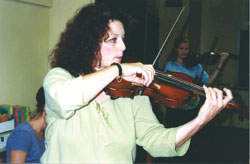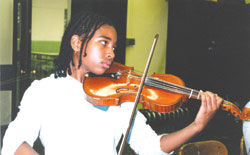|
 Guaspari
Makes Music in Harlem Guaspari
Makes Music in Harlem
by Marie
Holmes
“Rest
position. Put your violin out. Put your bow straight out.
Balance your weight–center your weight. Don’t wiggle!”
The students lined up in the basement of River East Elementary
clutch the tiny wooden instruments under their chins, trying
not to squirm, arms arched precariously above the strings in
preparation to bow. Finally, the notes rise, echoing off
the bare cement walls.
“Stop!”
screams Roberta Guaspari–Tzavaras. “What’s
wrong?”
“Somebody’s
off” says a little voice.
“More
than somebody’s off,” responds Guaspari. The group
lesson continues like this for the next sixty minutes, stopping
and starting to correct posture and technique, with Guaspari
pounding one foot against the linoleum with the regularity of
a metronome–and twice as loud. With all eyes on their
teacher, the children begin to play the national anthem, which
they perform every year at a Knicks game at Madison Square Garden.

Charged with maintaining order in a room full of active children
holding delicate instruments, Guaspari, both frazzled and determined,
could be any schoolteacher on this sunny September afternoon.
This teacher, however, is one of the most publicly celebrated
educators of recent years.
A child watches with fascination as she pulls out a copy of
her book, Music of the Heart, which preceded the movie of the
same name. “She’s famous,” whispers the girl
to the student standing next to her.
The 1998 film, in which Meryl Streep portrays Guaspari, was
the culmination of years of media attention that Guaspari’s
students had attracted in their struggle to keep their violin
teacher at River East and the Central Park East schools.
Guaspari, from Rome, New York, arrived in East Harlem in the
early eighties following the dissolution of her marriage. A
friend then studying at Union Theological Seminary convinced
her to move to the city with her two young sons. Once
there, she met Deborah Meier, founder of the three East Side
elementary schools, and the strings program was born. But in
1991 budget cuts went into effect, and Guaspari was told that
she would not have a job after the school year ended. “We
wrote everybody,” she recalls.
It was months before the media took notice. In April, The New
York Times ran a story in the Metro section. A request
from Prime Time Live followed. Yitzak Pearlman saw the segment
on TV and called Guaspari at her home. The famous violinist
agreed to attend the schools’ annual concert, after which
he gave an impromptu speech pleading for continued funding.
“He went up in front of the stage on his crutches,”
remembers Guaspari, “and he says ‘Bravo to these
kids and what I want to say is, let them play.’”
That year, Guaspari and friends managed to raise enough money
to pay for Guaspari’s salary and benefits. They
also founded the Opus 118 Music Center, named after the street
on which Guaspari still resides, just blocks from River East.
The Carnegie Hall concert in which students and famous musicians
shared the stage (re-enacted for the movie) was held in 1992.
And it was all on film.
The resulting documentary, the Oscar-nominated Small Wonders,
caught the attention of Miramax’s Harvey Weinstein, who
approached Guaspari about the possibility of a feature film.
Four years later, the media blitz having subsided, Guaspari
teaches in the same schools, lives in the same house on 118th
street, and has no plans to leave.
“I’m
not going to quit fighting for kids to have music in their lives,”
she asserts, “especially children in urban settings who
need it the most.”
Subsequent “fiddlefests”– including the upcoming
performance on November 14th at the Apollo theater– maintain
Opus 118, underwriting strings instruction in the elementary
and middle schools serving Harlem. While Guaspari’s salary
is now paid by the district, the organization sends other instructors
out into the schools, brings children to the Center for lessons
and helps train others in Guaspari’s unique method through
teacher training institutes.
While she admires the Suzuki approach, Guaspari’s teaching
style is more focused in the realities of classroom instruction.
“I’ve developed my own way of working with children
in a group,” she says, which includes her own inventive
vocabulary. “It’s gabble gobble–but it works.”
Posture, she believes, is fundamental. “You have to be
set up on the instrument with the right posture before you have
a chance.” But the first requirement is a music teacher.
“There are no strings teachers,” she laments. Visiting
artists and organizations, Guaspari says, “come in and
train the teachers and play a concert–and to me this is
just a tease. This pushes away the possibility for these kids
. . . it makes it more remote.”
Music education belongs in the core curriculum, she says, citing
studies that have shown improved academic performance in students
with early exposure to music instruction. Yet at the same time,
Guaspari sees music as a means to impart her students with less
quantifiable types of skills: “It empowers these children
with the ability to make something beautiful that allows them
to believe in themselves and know that they’re special.”
“Music,
to me,” she says, “is almost a spiritual way of
relating to another human being.”
Of all the students she has seen continue their music training,
there is one student in particular very near to her heart. Jose,
who now attends LaGuardia High School, lost his mother over
a year ago. At the funeral, says Guaspari, “he took
the violin out and he said ‘I’m going to play my
mother’s favorite song,’ and he played Ave Maria
. . . I don’t know how he was so composed,” she
marvels. “Violin changed his life.”#

Education
Update, Inc., P.O. Box 20005, New York, NY 10001.
Tel: (212) 481-5519. Fax: (212) 481-3919.Email: ednews1@aol.com.
All material is copyrighted and may not be printed without express
consent of the publisher. © 2002.
|
